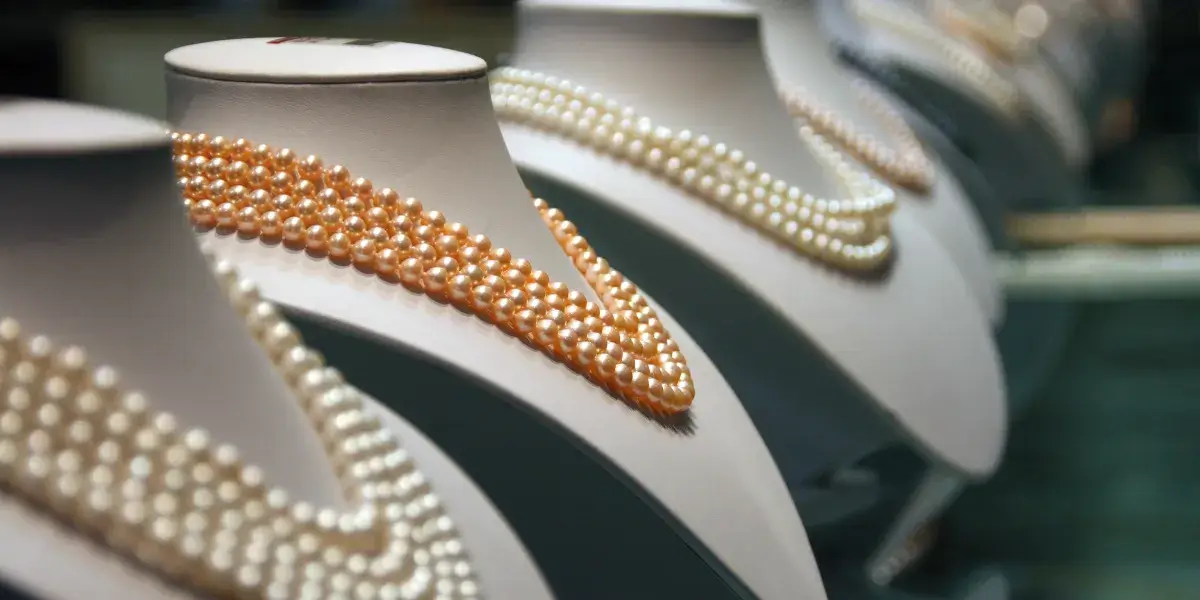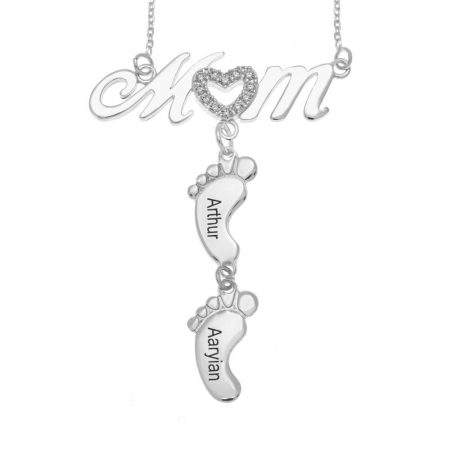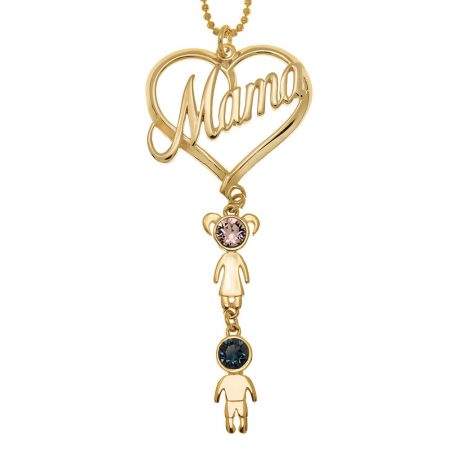Pearls have captivated humanity for millennia, revered for their timeless beauty and allure. From ancient civilizations to modern-day fashionistas, pearls are cherished in our hearts and jewelry boxes.
Let’s dive together into the world of pearls that unveils a rich tapestry of history, craftsmanship, and mystique.
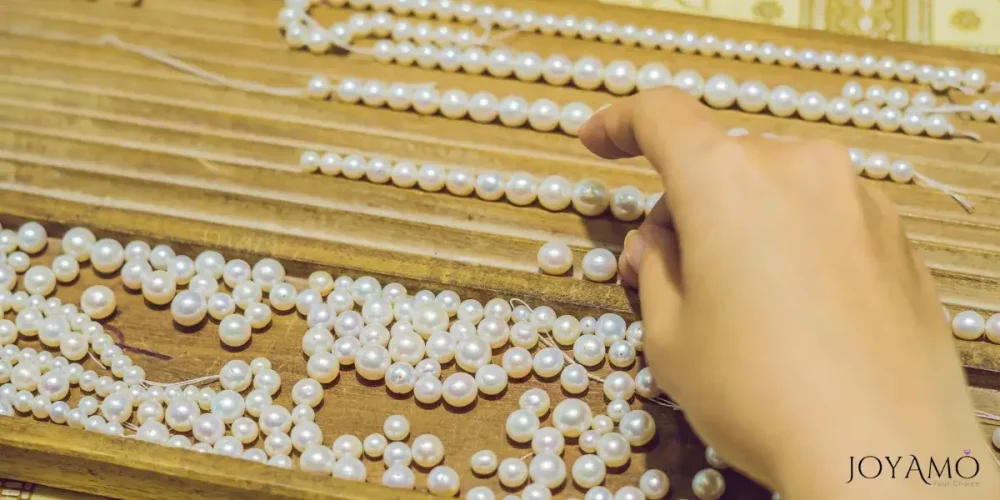
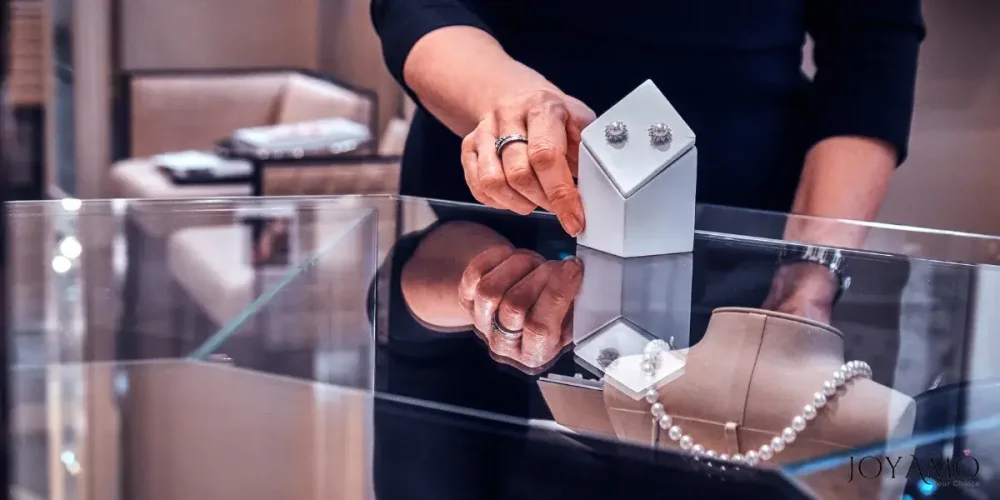
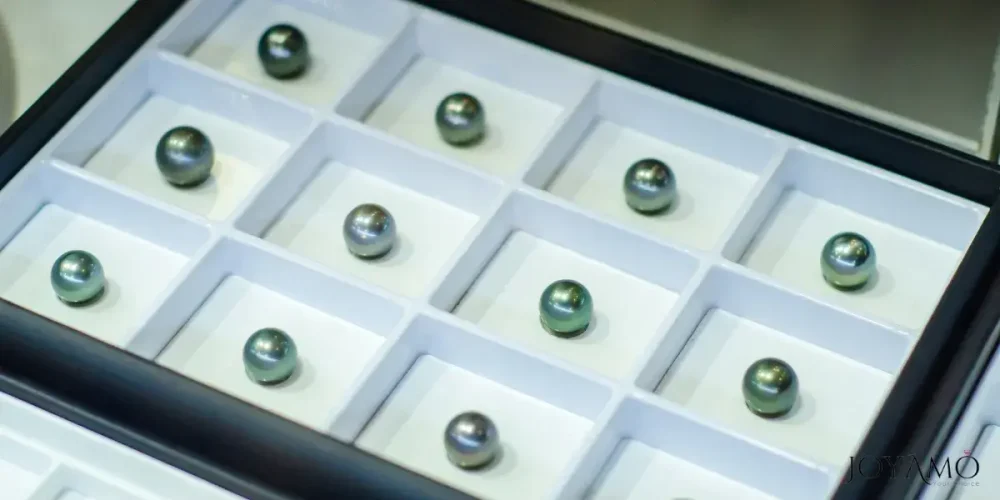
I.History of Pearls
The story of pearls dates back to when human civilizations first emerged, spanning across cultures worldwide.
Pearls have always been cherished for their beauty and scarcity holding significance in the hearts of people.
In societies like Mesopotamia, Egypt, and China pearls were highly valued for their meaning and exquisite looks.
They symbolized purity, wealth, and divine connections in these civilizations.
Royalty, priests, and nobles adorned themselves with pearls on crowns, jewelry, and ceremonial attire.
The ancient Greeks viewed pearls as tears shed by the gods while the Romans associated them with love and fertility.
Throughout the ages, people have dived into oceans, rivers, and lakes to harvest pearls.
Natural pearls formed inside mollusks as a reaction to irritants were extremely rare and sought after.
The pursuit of these jewels led explorers and traders to distant lands in search of pearl sources to meet demand.
Pearl diving became an industry in areas like the Persian Gulf, Red Sea, and Southeast Asia waters.
The discovery of pearl beds triggered prosperity and cultural interactions that influenced events such, as trade routes and diplomatic ties.
During the Renaissance era, pearls were highly favored, gracing the outfits of monarchs and nobles.
Artwork from that time showcases noblewomen adorned with pearls symbolizing richness, sophistication, and social standing.
Nowadays, advancements in pearl farming techniques transformed the pearl industry.
Cultivated pearls created with assistance became more attainable and budget-friendly making the charm of pearls accessible, to an audience.
Today pearls continue to captivate and inspire people for their timeless grace and enduring charm.
Their extensive past stands as proof of the allure surrounding these ocean treasures.
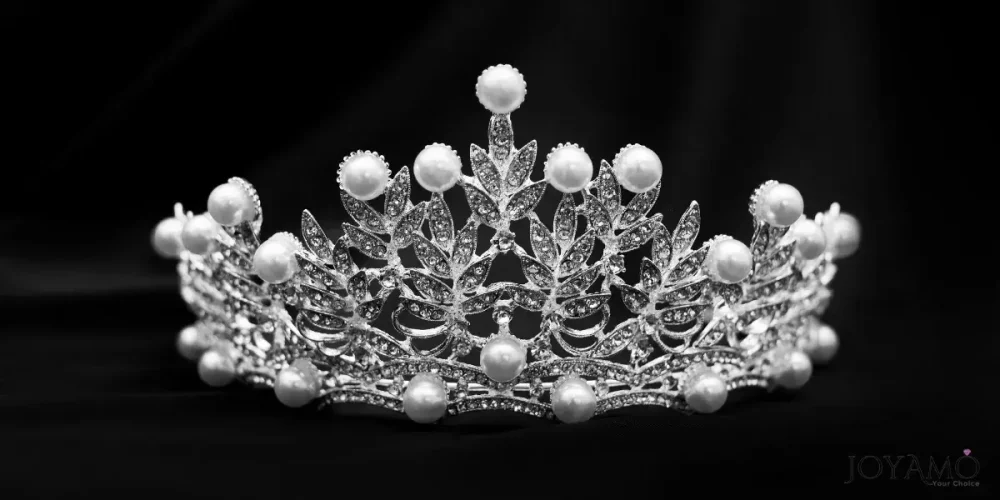
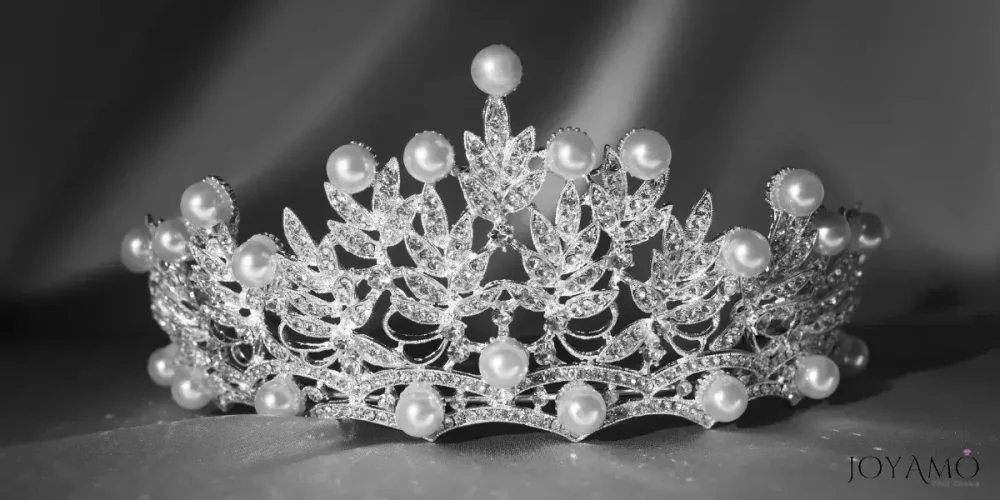
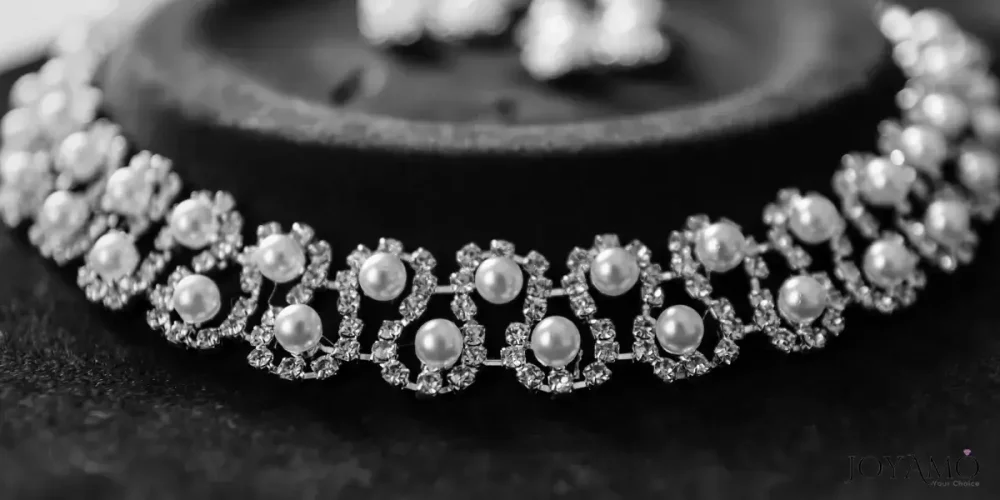
II. How can you tell if pearls are real
Throughout history civilizations worldwide have been captivated by the allure of pearls that originate from the depths of the sea.
In societies pearls symbolized wealth, prestige, and purity, often gracing the regalia of kings and nobles in ornate adornments.
Myths and folklore are rich, with stories that only add to the mystique surrounding these gems.
There exist three categories of pearls: natural, cultured, and imitation.
✔ Natural pearls
Natural pearls are a rarity forming inside mollusk species like oysters and mussels due to irritants such as sand grains prompting the mollusk to create layers of nacre around it over time.
Because natural pearls are so scarce, their formation is unpredictable therefore they hold high worth in markets.
✔ Cultured pearls
Cultured pearls are nurtured through intervention.
Pearl farmers meticulously introduce irritants into mollusks and oversee their development until pearls take shape.
Cultured pearls have become more prevalent in today’s markets as an alternative to natural ones, offering a variety of shapes, sizes, and hues to cater to different preferences.
Genuine pearls possess qualities that differentiate them from fakes. Real pearls have a sheen that radiates from within reflecting light with an iridescent shimmer.
Their surfaces are typically smooth with variations and imperfections that indicate their origin. Pearls have weight and warmth when held, unlike the cooler feel of fake pearls.
✔ Artificial pearls
Faux pearls, also known as imitation pearls, are crafted from materials like glass, plastic, or shell beads.
While they may mimic the look of natural pearls to some degree, they lack the richness, shine, and value of pearls.
These imitation pearls offer a budget alternative for those desiring the elegance of pearls without the price tag.
Both buyers and sellers need to be able to distinguish pearls from imitations.
Pearls symbolize enduring elegance, sophistication, and timeless beauty.
Exploring their origins, varieties, and the significance of authenticity deepens our admiration for these treasures, from the sea depths.
Being cultured or an imitation, pearls continue to captivate and inspire generations with their charm.
Differences between natural pearls, cultured pearls, and artificial pearls
| Characteristic | Natural Pearls | Cultured Pearls | Artificial Pearls |
|---|---|---|---|
| Formation Process | Formed naturally inside mollusks | Mollusks seeded by humans to initiate growth | Manufactured using synthetic materials |
| Rarity | Extremely rare | More readily available | Abundant and easily produced |
| Value | Very high | Variable, depending on quality and type | Low, generally inexpensive |
| Lustre | Lacks natural luster, may appear artificial | Varies, depending on the quality of the nacre | Uniform surface lacks natural irregularities |
| Surface Quality | May have imperfections | Varies, but typically smoother surface | The uniform surface lacks natural irregularities |
| Shape Variability | Varied shapes and sizes | Varied shapes and sizes | Typically uniform in shape and size |
| Price Range | Very high | Moderate to high | Low |
| Cultivation Methods | Occurs naturally in the wild | Mollusks are cultivated on farms | Created in factories using manufacturing processes |
| Market Availability | Rare and limited availability | Widely available | Widely available and accessible |
| Authentication | Requires expert evaluation to verify | Can be certified by gemological institutes | Easily identifiable as man-made |
| Sustainability | Sustainable, but environmentally sensitive | More environmentally friendly than natural pearls | Environmentally friendly, but lacks natural origins |
III.Physical Characteristics of Real Pearls
The physical characteristics of pearls are what make them truly captivating and distinguish them from their counterparts.
Real pearls are known for their beauty attributed to three features; their luster, surface quality, and shape.
Luster is a defining trait of pearls showcasing a radiant glow that seems to emanate from within due to light reflecting off the layers of the nacre.
This luminous quality, often described as “pearlescent” or “iridescent “, displays color variations when viewed from different angles.
The luster of pearls adds to their charm and serves as a clear indicator of their genuineness.
Surface quality also plays a role in identifying pearls. While genuine pearls may exhibit imperfections like blemishes or irregularities, they typically maintain a uniform appearance.
These natural markings are considered part of the pearl formation process and signify their authentic nature.
When it comes to imitation pearls, they often lack the details and depth that real pearls possess.
Examining a pearl closely under magnification reveals the differences that set pearls apart from fake ones.
Pearls come in shapes, influenced by their type and how they are cultivated.
Round pearls are highly valued for their uniformity and balance making them popular for jewelry.
Oval pearls have an elongated shape while baroque pearls showcase asymmetrical forms adding character to these organic gems.
Although differing shapes can be present in pearls they all hold their beauty.
The physical traits of pearls such as shine, surface texture, and shape play a role in identifying their genuineness.
Understanding and admiring these qualities allows enthusiasts and collectors to confidently distinguish between pearls and imitations preserving the timeless allure of these precious treasures.
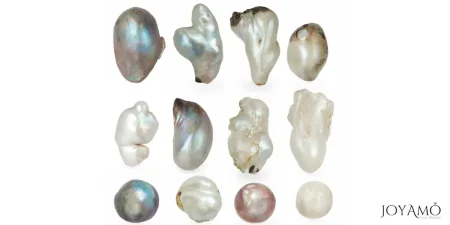
Different types of natural pearls
| Type of Natural Pearl | Description | Examples |
|---|---|---|
| Akoya Pearls | Historic natural pearls found in the freshwater mussels of the Mississippi River, are known for their unique shapes and colors. | Mikimoto pearls, Hanadama pearls |
| South Sea Pearls | Cultivated in the warm waters of the South Pacific, larger with a creamy to golden color and exceptional luster. | Australian South Sea pearls, Philippine pearls |
| Tahitian Pearls | Cultivated in the black-lipped oyster in French Polynesia, known for their exotic dark colors and overtones. | Peacock, grey, green, and black Tahitian pearls |
| Freshwater Pearls | Cultivated in freshwater lakes, rivers, and ponds, typically smaller in size and available in a wide range of colors. | Chinese freshwater pearls, Biwa pearls |
| Conch Pearls | Rare pearls are found in the Queen Conch mollusk, known for their pink to orange hues and unique flame-like patterns. | Queen Conch pearls |
| Abalone Pearls | Produced by the abalone mollusk, characterized by their vibrant iridescence and range of colors including blues and greens. | Paua pearls, Haliotis pearls |
| Melo Melo Pearls | Rare pearls from the Melo Melo sea snail, prized for their large size, golden-orange color, and unique flame-like patterns. | Melo pearls |
| Mississippi River Pearls | Historic natural pearls found in the freshwater mussels of the Mississippi River are known for their unique shapes and colors. | Historic natural pearls found in the freshwater mussels of the Mississippi River, are known for their unique shapes and colors. |

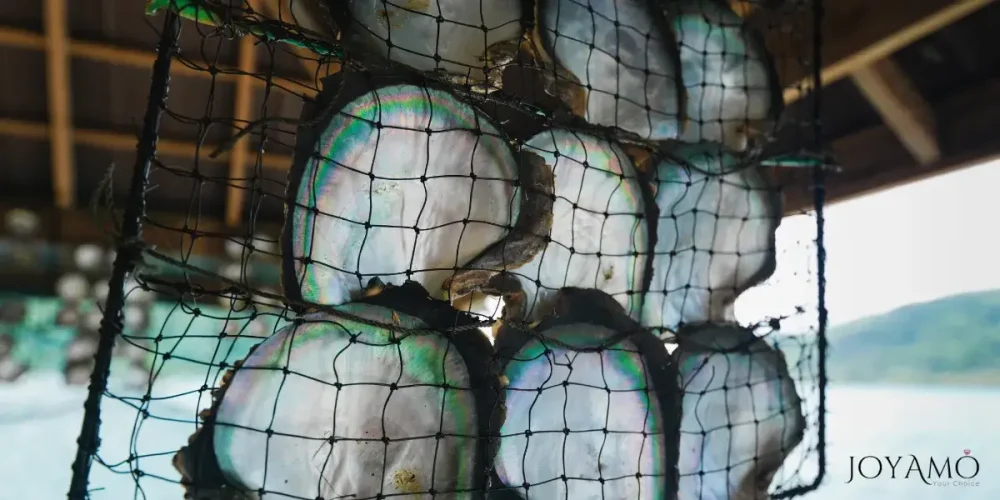
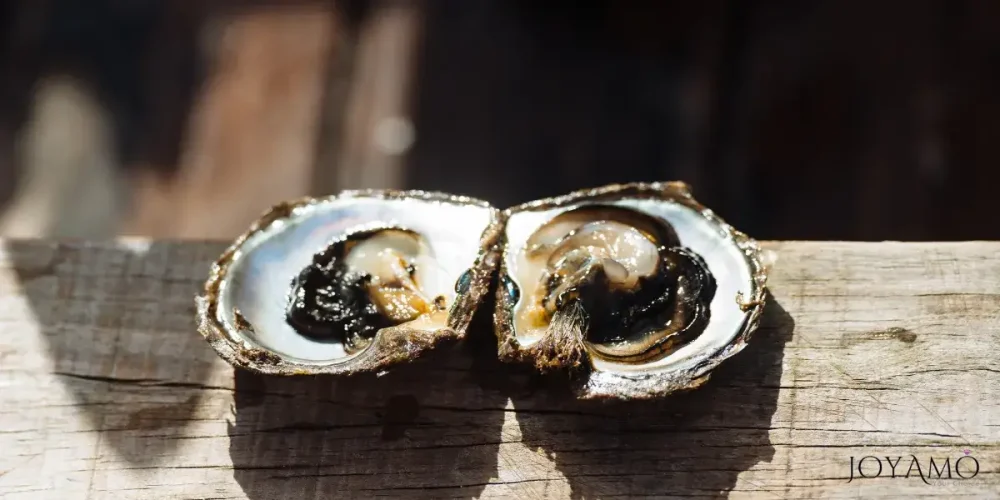
IV. Identifying Fake Pearls
Methods and Techniques
In the jewelry world, the timeless elegance of pearls holds a special place, but amidst their splendor lies the challenge of discerning genuine pearls from their counterfeit counterparts.
To deal with this intricate landscape, it’s essential to equip oneself with knowledge and employ various testing methods.
Here’s a comprehensive guide to identifying fake pearls by way of different methods and techniques:
- Check for Tiny Irregularities: Real pearls often have tiny imperfections on their surface, such as dimples, bumps, or irregularities. These natural blemishes, known as “growth marks,” are indicative of authentic pearls, as they form during the mollusk’s development process. In contrast, imitation pearls tend to have a flawless and uniform appearance, lacking the subtle nuances found in genuine pearls.
- Feel the Hardness: Authentic pearls possess a certain degree of hardness due to the layers of nacre that compose their structure. When gently pressed between the fingertips, real pearls will feel firm and resistant to pressure. In contrast, imitation pearls made from materials like glass or plastic may feel softer or more pliable, lacking the solidity characteristic of genuine pearls.
- Scrutinize the Size: While pearls can vary in size, genuine pearls typically exhibit consistency within a strand or piece of jewelry. Discrepancies in size or shape among pearls may indicate the presence of imitation pearls mixed in with genuine ones. Careful observation and comparison of individual pearls can reveal inconsistencies that betray the authenticity of the entire piece.
- Check the Pigmentation: Natural pearls display a subtle variation in color, with hues ranging from creamy white to soft pink, golden, or even grayish tones. Imitation pearls often lack this nuanced coloration and may appear too uniform or artificial in pigment. Look for hints of iridescence or overtone colors, which are characteristic of genuine pearls and add depth to their beauty.
- Inspect the Color and Luster: The color and luster of pearls are key indicators of their authenticity. Genuine pearls exhibit a natural sheen or luster that emanates from within, casting a soft glow when exposed to light. Imitation pearls may appear dull or overly shiny, lacking the subtle iridescence that distinguishes real pearls.
- Perform the Tooth Test: A traditional method for identifying real pearls involves gently rubbing the pearl against the biting edge of your teeth. Real pearls have a slightly gritty texture due to the layers of nacre, while imitation pearls feel smooth or slippery. Exercise caution to avoid damaging the pearls, especially with delicate or valuable pieces.
- Perform the Rub Test: Another test involves rubbing two pearls together gently. Real pearls will produce a slight resistance and may emit a faint powdery substance, known as “pearl dust,” due to the friction between their layers. Imitation pearls, lacking this layered structure, will typically feel smoother and may produce no residue.
- Use the Fire Check: In this method, a needle or pin is heated and then touched to the surface of the pearl. Real pearls will emit a faint, smoky scent resembling burnt hair, while imitation pearls may emit a plastic or chemical odor. Exercise caution when using this method, as excessive heat can damage pearls.
If you employ these testing methods and techniques, you can confidently distinguish genuine pearls from their counterfeit ones.
In this way, you are sure that your jewelry collection is adorned with the timeless beauty of authentic pearls.
As a seasoned connoisseur or a novice enthusiast, you can have the ability to identify real pearls and enhance your appreciation for these exquisite treasures from the sea.
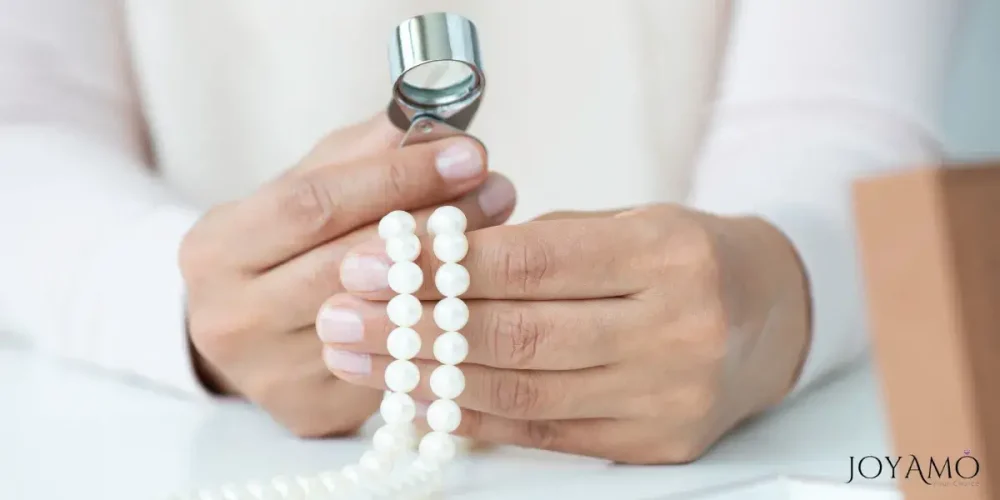
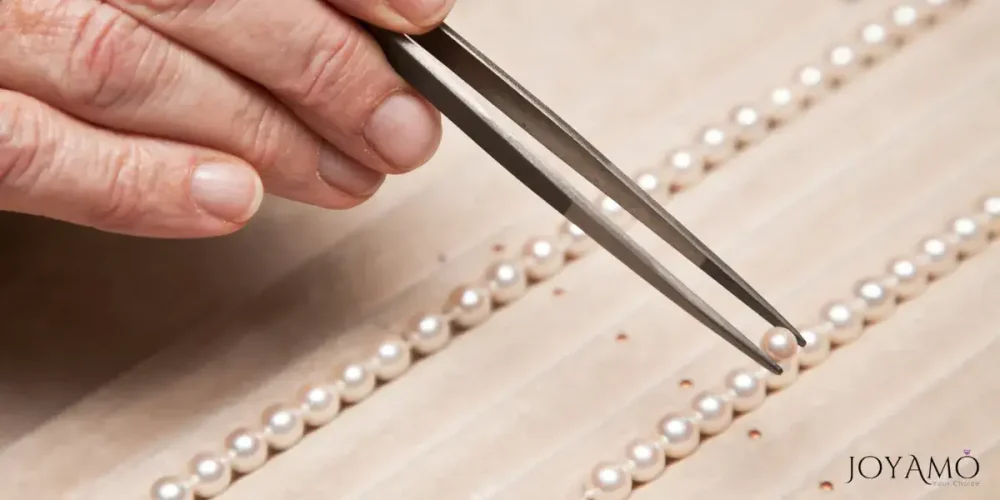
Methods for identifying fake pearls
| Method | Description | Advantages | Disadvantages |
|---|---|---|---|
| Check for Tiny Irregularities | Examining the surface of pearls for small imperfections or irregularities. | Provides insight into the natural formation of pearls | Requires close inspection; may not be definitive |
| Feel the Hardness | Rubbing two pearls together to assess the resistance and presence of pearl dust. | Quick and easy; provides tactile feedback | Requires experience to discern subtle differences |
| Scrutinize the Size | Observing the consistency of size and shape within a strand or piece of jewelry. | Helps detect inconsistencies in pearl size | Relies on comparison and may vary among pearls |
| Check the Pigmentation | Evaluating the natural variation in color and iridescence of pearls. | Reveals nuances in color typical of real pearls | Subjective; requires a trained eye |
| Inspect the Color and Luster | Assessing the depth and sheen of pearls when exposed to light. | Provides visual indication of pearl quality | May be influenced by lighting conditions |
| Perform the Tooth Test | Rubbing pearls against the biting edge of teeth to feel for texture differences. | Traditional method with historical significance | Potential for damage to pearls; not always conclusive |
| Perform the Rub Test | Rubbing two pearls together to assess resistance and presence of pearl dust. | Provides tactile feedback and visual cue | May not be definitive; requires experience |
| Use the Fire Check | Applying heat to pearls and observing the scent emitted. | Can help differentiate between organic and synthetic pearls | Requires caution and may damage pearls |
V. Buying Tips for Pearls
When you’re in the market for buying pearls it’s important to arm yourself with knowledge to ensure you’re making a good-quality purchase.
Here are some useful pointers to keep in mind”
- Trusted Sources: Choose well-known sources when shopping for pearls. Established jewelers, certified pearl experts, and popular online stores are options. Make sure they provide pearls backed by certifications and guarantees.
- Considering Prices: Be cautious of deals that appear good to be true as they could signal pearls or subpar quality. Authentic pearls come at a price determined by factors such as size, shape, luster, and origin. Compare prices from sellers to gauge market rates. Avoid overpaying.
- Spotting Fake Pearls: Watch out for signs that might indicate fake pearls are being sold at prices. These signs include shapes and sizes unnatural colors or shine and excessively smooth surfaces. If the price seems low for the quality promised it’s wise to approach with skepticism and examine the pearls carefully.
- Importance of Researching Sellers: When you’re considering a seller it’s important to check out their reputation, credentials, and customer feedback to assess how reliable and trustworthy they are. Take a look at what previous buyers have to say about the pearls’ quality, the level of customer service provided, and their return policies.
- Reviewing Feedback; Reading through reviews left by customers can give you insights into both the buying process and the quality of the products. Seek out reviews on review sites, social media platforms, or forums dedicated to jewelry enthusiasts. Pay attention to any themes or compliments that show up in reviews.
Follow these purchasing suggestions so you’ll be able to navigate the pearl market and make informed and wise choices that guarantee you receive genuine top-quality pearls at reasonable prices.
Keep authenticity, trustworthiness, and customer happiness in mind when picking a seller, and feel free to ask questions or gather details before finalizing your purchase.
VI. Care and Maintenance of Pearls
📌 Taking Care of Your Pearls
Pearls, known for their timeless elegance and fragile nature need attention and upkeep to maintain their shine and durability over time.
Here are some key tips to ensure your pearls stay luminous and stunning for years to come.
📌 Pearls proper Storage Methods
It’s crucial to store pearls to prevent any scratching, discoloration, or harm.
To preserve their quality keep pearls separate from jewelry items to avoid any friction with materials.
It’s best to store them in a pouch or a lined jewelry box from direct sunlight and heat.
Avoid storing pearls in sealed containers as they require a level of moisture to prevent drying out and becoming brittle.
📌 Pearls Cleaning
Cleaning pearls should be done carefully to protect their surface from damage.
Simply wipe the pearls gently with a cloth after each use to remove dirt sweat or oils.
Avoid using chemicals, abrasive cleaners, or ultrasonic cleaners as they can dull the luster and shimmer of the pearls.
If needed use a soap or detergent diluted in water for a gentle cleaning process, then rinse thoroughly and softly dry them with a cloth.
Let the pearls air dry completely, before storing them
📌Pearls Precautions
To keep your pearls in condition it’s important to protect them from chemicals, acids, and extreme temperatures.
Avoid contact with perfumes, cosmetics, hairspray, and household cleaners as these can harm the pearls’ luster and quality over time.
When getting dressed make sure to put on your pearls and take them off first to minimize exposure to substances.
It’s also best to avoid wearing pearls while swimming or bathing as chlorine and saltwater can damage their structure.
Extreme temperature changes can also impact pearls negatively by causing them to expand or contract potentially leading to cracking or warping.
To prevent this avoid temperature fluctuations like placing pearls near heaters or air conditioners, and store your pearls in an environment with humidity levels for optimal care.
To sum it up, taking care of your pearls is vital for maintaining their beauty and longevity.
We invite you to follow these tips on storage cleaning and protecting them from chemicals and extreme temperatures so you can ensure that your pearls remain a keepsake for years to come.
Treat your pearls with the consideration they deserve so they will exude their timeless charm for generations.
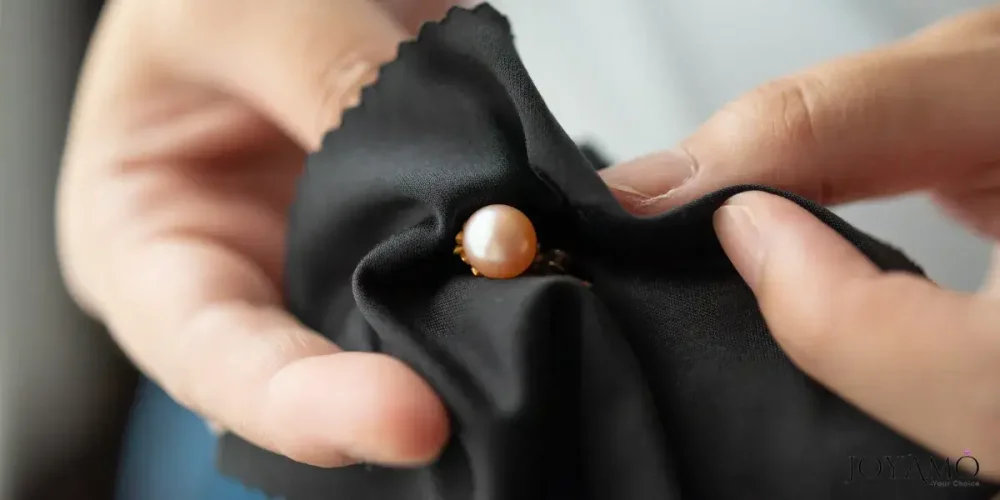
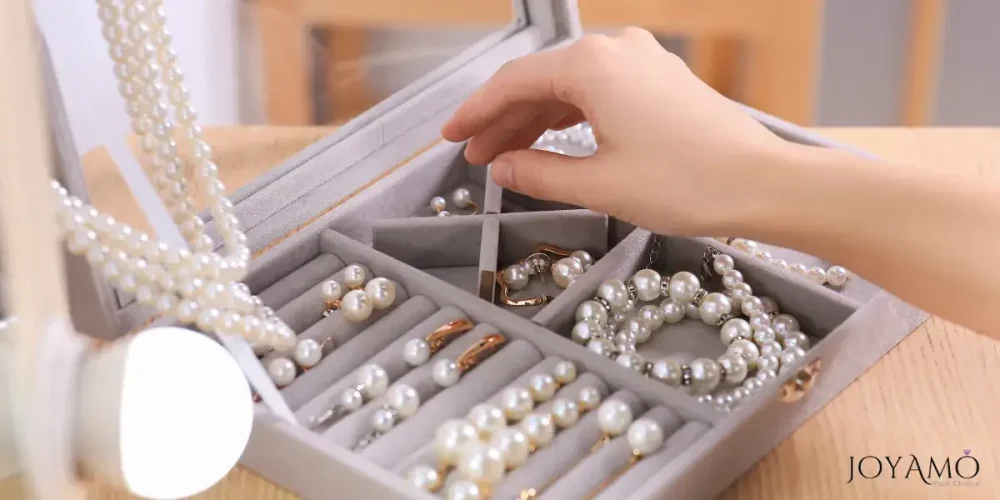
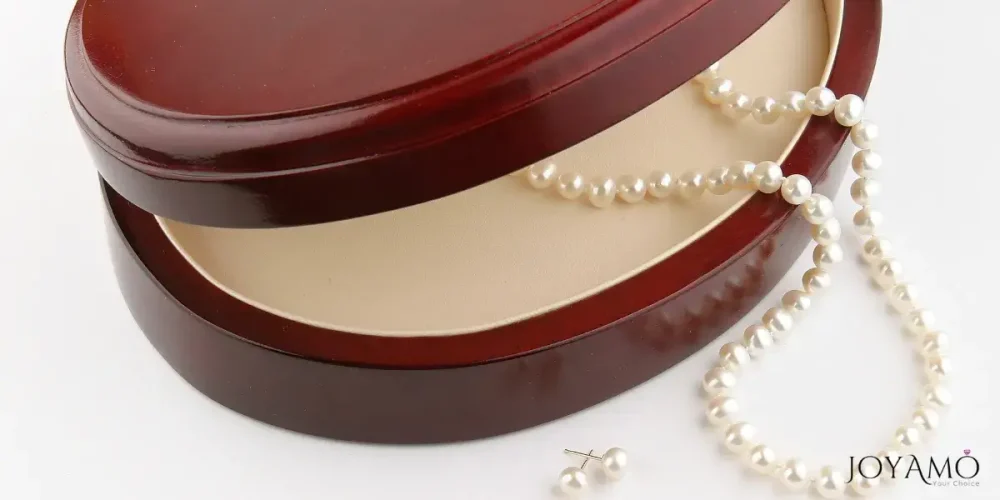
VII.Pearls in the World of Jewelry
For centuries pearls have enchanted jewelry lovers with their charm and natural beauty.
Throughout history from civilizations to fashion scenes, pearls have symbolized elegance and refinement.
Let’s discover the realm of pearls and their significance in jewelry, including necklaces, bracelets, and earrings.
✔ Pearl Necklaces
Pearl necklaces stand as pieces of jewelry that grace the necks of royalty, celebrities, and style designers.
Showcased in strands of exotic Tahitian varieties, pearl necklaces radiate sophistication and grace making them ideal for both formal events and everyday wear.
Available in a range of lengths and designs from choker-style strands to opera-length ropes, pearl necklaces offer versatility and enduring charm.
Contemporary creations infuse pearls into necklace designs like layered chains with pearl detailing or pendant necklaces highlighting a radiant pearl as the focal point.
✔ Pearl Bracelets
Pearl bracelets bring an air of elegance to any wrist when worn solo or layered with bracelets for a standout look.
Traditional pearl bracelets feature strands of pearls fastened with a clasp presenting a timeless accessory for all occasions.
Contemporary jewelry designs often showcase pearls in ways like bangle bracelets adorned with pearls or stretch bracelets with a mix of pearls and gemstones.
Pearl cuff bracelets make a strong fashion statement by blending the classic charm of pearls with modern design elements for a distinct accessory.
✔ Pearl Rings
Choosing pearl rings adds a touch of romance and femininity to any outfit.
Solitaire pearl rings typically highlight a pearl at the center often surrounded by diamonds or other precious stones for brilliance.
Cluster rings feature intricate designs with multiple pearls creating beautiful floral or geometric patterns that catch the eye.
Modern pearl rings come in unconventional settings and shapes including bypass bands, open designs, or stackable styles offering endless options to showcase personal flair.
✔ Pearl Earrings
Pearl earrings are an addition to any jewelry collection, exuding subtle elegance and sophistication.
Classic stud earrings with pearls are timeless pieces for both everyday wear and formal events.
Drop earrings boast pearls hanging from hooks or posts adding movement and grace to any look.
Hoop earrings with pearls give a take on a style blending the casual charm of hoops with the graceful touch of pearls for a trendy look.
To sum it up, pearls retain their motivating allure in the realm of jewelry providing enduring grace and sophistication in necklaces, bracelets, rings, and earrings.
Donned individually to make a statement or mixed with jewelry for a unique style, pearls stand as an emblem of elegance and beauty that surpasses fashion trends and eras.
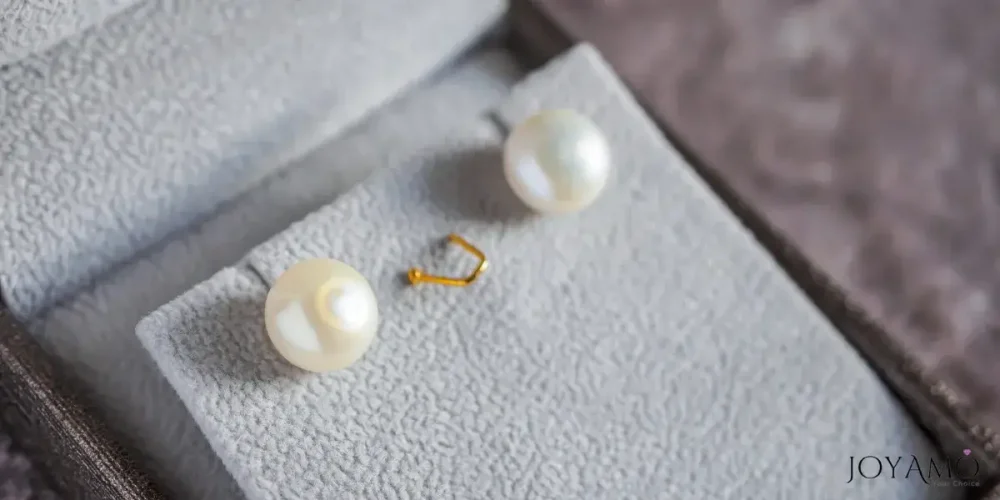
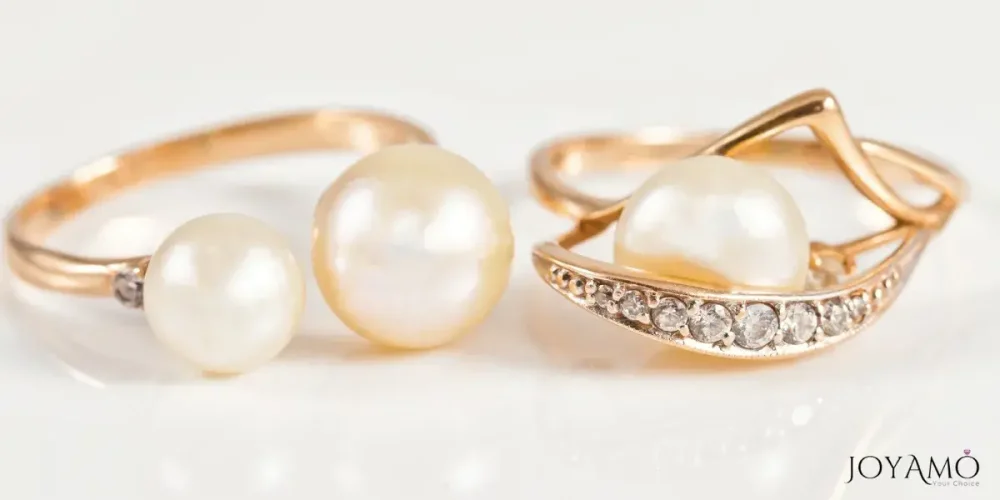
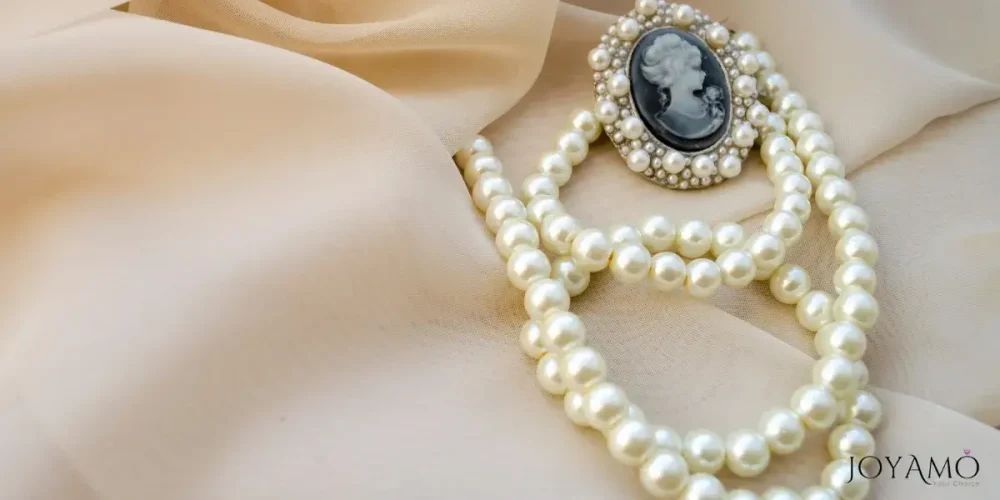
VIII.Pearls and Personalities: a love story
The bond between personalities and royalty and pearl jewelry runs deep with a history of cultural significance that spans centuries.
From Hollywood stars to royals, pearls have always been cherished by the class for their timeless beauty and royal charm.
Celebrities are often spotted wearing pearl jewelry both on the carpet and in their lives.
Iconic figures like Audrey Hepburn, Grace Kelly, and Elizabeth Taylor embodied elegance and sophistication through their choice of pearl adornments showcasing the charm of pearls in their signature styles.
Today’s celebrities also embrace pearls as a mark of refinement and allure frequently wearing them at high-profile events and movie premieres.
Even men fall for pearl jewelry wearing pearl necklaces on the red carpet, at movie premieres, and even on stage.
The actor Timothée Chalamet, the singer Harry Style, and the rapper A$AP Rocky are among those who strike pearls in an unmatched manner.
Likewise, members of royalty have shown a fondness for pearls throughout history incorporating these gems into their royal attire.
From Queen Elizabeth I of England to Empress Josephine of France, pearls have embellished crowns, tiaras, and gowns as symbols of wealth, status, and influence.
Royal figures like Queen Elizabeth II and Princess Diana have upheld this tradition by wearing pearls at banquets, official functions, and public events.
The connection, between celebrities, rulers, and pearl jewelry transcends fashion statements.
Pearls are often linked with elegance, class, and everlasting charm qualities that appeal to celebrities, personalities, and royalty alike.
Worn as a necklace, a set of earrings, or an adornment on a crown, pearls exude a sense of sophistication and grace that surpasses fashion trends and spans across generations.
Moreover, pearls carry importance in societies, symbolizing purity, wisdom, and prosperity.
For celebrities and royalty adorning themselves with pearls can evoke feelings of heritage and customs establishing a connection to the rooted history and cultural meaning associated with these radiant jewels.
The bond between celebrities, royalty, and pearl accessories is characterized by respect and admiration for the timeless allure and sophistication embodied by pearls.
Embraced by Hollywood icons or monarchs around the world, pearls continue to enchant and motivate individuals as enduring symbols of elegance, classiness, and royal charm.









💡How Can You Tell if Pearls are Real FAQs
✔ What is the easiest way to tell if a pearl is real?
One way to check if a pearl is genuine is by doing a tooth test. Just rub the pearl against your teeth’s edge. Real pearls have a texture because of the nacre layers while fake pearls feel smooth. Be careful when using this method to avoid harming the pearls.
✔ How do you test pearls with vinegar?
Another test for pearls involves using vinegar. You can soak them in a bit of vinegar for a period. If they are real they won’t be affected by the vinegar. However, if they are fake or made of materials like plastic or glass they might show signs of damage or color changes when exposed to vinegar.
✔ How can you tell the difference between natural and artificial pearls?
Distinguishing between artificial pearls can often be done through examination and testing. Natural pearls usually display imperfections or irregularities on their surface whereas artificial ones may seem flawless or consistent. Natural pearls have a weight and texture that sets them apart from ones that can feel lighter or less substantial.
✔ Are real pearls heavy or light?
Real pearls are generally heavier than ones because of the layers that form their structure giving them a particular density and weight. Real pearls have a substantial feel when you hold them, unlike artificial pearls that might feel lighter or less dense because they are made of materials such, as glass, plastic, or shell beads.
✔ Are fake pearls obvious?
Sometimes it’s easy to spot pearls especially if you take a look. While some fake pearls are made to look very similar, to ones they often lack the richness, shine, and natural imperfections that genuine pearls have. Certain types of pearls like those made of plastic or glass may show signs of being artificial such as seams or feeling hollow. However with manufacturing methods these days some fake pearls can be quite convincing so it’s important to inspect them before buying.
✔ How can you tell the difference between cultured pearls and fake pearls?
Telling the difference between fake pearls requires paying attention to details and using testing techniques. Cultured pearls are created inside mollusks with intervention resulting in pearls with nacre layers. One way to distinguish them from fakes is by checking for surface flaws; cultured pearls might still have irregularities while imitation ones might look too perfect. Also, cultured pearls usually have weight and texture when you hold them compared to ones that might feel lighter or less substantial due, to their materials.
 SHIPPING
SHIPPING
